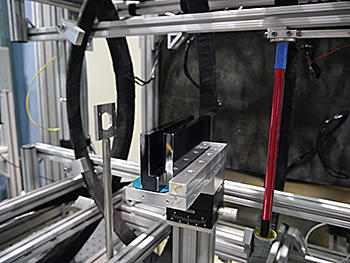Fundamental Physics: Measurement of the Neutron Magnetic Dipole Moment Using Schwinger Scattering
Summary
We measured the neutron interaction with an atomic field (also known as Schwinger scattering) inside a silicon crystal in order to determine the value of the neutron magnetic dipole moment. A successful Schwinger scattering experiment provides "proof of principle" for measuring of the neutron electric dipole moment (EDM) using a similar technique. This technique is completely different from standard neutron EDM experiments which use ultracold neutrons (UCN) in high magnetic fields thus providing a different perspective on systematic errors of EDM experiments. Previous attempts done by Shull and others did not produce the results consistent with theoretical predictions.
Description

Photograph showing the precession coil and slotted silicon crystal installed in the apparatus on the NG-6a monochromatic beam line. The neutron beam goes from right to left.
Schwinger scattering is caused by the interaction between the neutron's magnetic dipole moment (MDM) and the atomic electric field inside a silicon crystal. The atomic electric field with a magnitude of 108 V/cm induces a tiny magnetic field in the rest frame of the moving neutron and thus a torque that rotates the neutron polarization by a very small angle (about 3.2 x 10-4 radians). To magnify this rotation, a neutron beam is Bragg reflected down a narrow slot cut from perfect silicon. At each consecutive reflection a magnetic field rotated the neutron polarization by π/2 in order for the Schwinger scattering effect to accumulate. For 135 successive reflections off of the (220)-planes of our crystal a 0.384 nm neutron experienced a small but measurable total rotation of 0.043 radians.
The figure in the top right shows the experiment setup. Neutrons are polarized via a neutron supermirror polarizer. Afterwards the neutrons' polarization direction is rotated 90 degrees using a copper precession coil before it enters the slotted crystal. Here the (220)-planes of the silicon crystal were oriented perpendicular to the slot wall. A constant, uniform magnetic field of 17 G is provided by four coils. Two additional pairs of coils cancel any external magnetic fields. The Schwinger interaction will rotate the neutron polarization creating a measurable net change in the neutron polarization along the beam direction. The neutron polarization is analyzed by a second supermirror polarizer located at the end of the experimental apparatus. Polarized 3He spin filters were also employed instead of supermirrors to avoid a small systematic effect associated with rotating the neutron spin from the vertically oriented magnetic field of the supermirror to the longitudinal direction of the magnetic field at the crystal.
The results have been published in Physical Review C (T.R. Gentile, M.G. Huber, D.D. Koetke, M. Peshkin, M. Arif, T. Dombeck, D.S. Hussey, D.L. Jacobson, P. Nord, D.A. Pushin, and R. Smither, Phys. Rev. C 100, 034005 (2019). “Direct observation of neutron spin rotation in Bragg scattering due to the spin-orbit interaction in silicon”).

